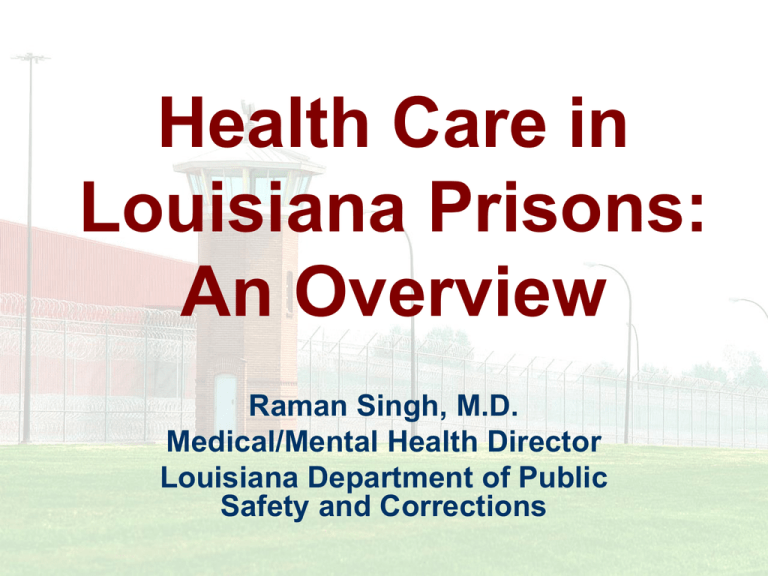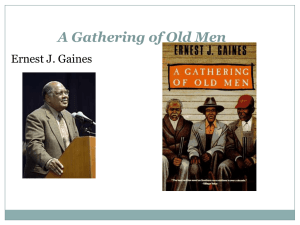Health-Care-in-La-Prisons-Dr.-Singh
advertisement

Health Care in Louisiana Prisons: An Overview Raman Singh, M.D. Medical/Mental Health Director Louisiana Department of Public Safety and Corrections Overview Louisiana Corrections Health Care • Our great nation also has the highest incarceration rate in the world and many of the incarcerated individuals are a product of; broken families, broken educational system, unhealthy job market , lack of access to adequate health care, etc. • Over the years, Correctional leaders have come to realize that the traditional “lock and feed" model is only adding fuel to the fire and now there is a strong wave of re entry efforts to tackle the core issues of the criminal justice system. • The focus has shifted from “ minimum to get by” to “ finding and implementing best practices to build and run an efficient correctional health care system”. It is often said that the measure of a civilization is how it treats it’s weakest members, the last, the least, the littlest. A Right to Medical & Mental Health Care for the Incarcerated Landmark Case of Estelle v. Gamble 1) Right of access to health care 2) Right to care that is ordered 3) Right to a professional medical judgment Those that are incarcerated do not have the ability to drive to the nearest emergency room or call for assistance for a serious medical need. He or she relies on prison officials in those instances. Overview Louisiana Corrections Health Care Staggering numbers of individuals are incarcerated who have; serious mental health conditions, multiple risk factors for heart conditions, cancers and infectious diseases who lacked access to health care before their incarceration. The number of elderly offenders is growing at an alarming rate, further burdening already strained state budgets. At the same time, the health care field is advancing at a very fast pace. New technological inventions are happening every day which are changing the landscape dramatically for good but also raising the price tag. The Congressional Budget Office has found that "about half of all growth in health care spending in the past several decades was associated with changes in medical care made possible by advances in technology." Snapshot of Louisiana • According to the Federal Bureau of Justice & Statistics, Louisiana has the highest offender death rates in the country. It is because we have the highest number of HIV + people, sit in the cancer belt, and have one of the worst obesity problems leading to a higher number of heart disease. • In 2007, 65% of adults in Louisiana were overweight or obese. Snapshot of Louisiana Most Common Causes of Death Rate per 100,000 population Reference: CDC, Louisiana: Burden of Chronic Disease, 2008 Respiratory Disease 44.5 43.2 57.6 46.6 Stroke LA US 209.3 183.8 All Cancers 255.7 Heart Disease 211.1 0 50 100 150 200 250 300 HIV in Louisiana • In the most recent CDC HIV Surveillance Report (Vol. 22), Louisiana ranked 4th highest in estimated state AIDS case rates (20.0 per 100,000) and 11th in the number of estimated AIDS cases in 2010. • In 2009, Louisiana ranked 5th highest in estimated state AIDS case rates (19.4 per 100,000) and 12th in the number of estimated AIDS cases. • In the CDC HIV Surveillance Report (Vol. 22), the Baton Rouge metropolitan area ranked 1st in estimated AIDS case rates (33.7 per 100,000) and the New Orleans metropolitan area ranked 5th in estimated AIDS case rates (26.2 per 100,000) in 2010 among the large metropolitan areas in the nation. Current Chronic Illnesses Diagnosed in Louisiana DOC Facilities Chronic Disease 2009 2012 % Population Increase in diagnosis Hypertension 4,346 5,436 29.6% population 25% Diabetes 1,178 1,301 7.1% population 9% Cancer 193 216 1.2% population 9% Heart Disease 271 308 1.7% population 11% Pulmonary Disease 890 1,221 6.6% population 26% HIV 542 549 3% population 1.2% Hepatitis C 2,270 2,017 11% population 11% DECREASE Health Care Work load Comparison 2008 - 2012 • Due to the aging population, offender’s health care needs are increasing which is also being seen in the communities (similar increase is being reported in the medical journals as age is the main driving factor). • Examples of the impact are; – For offenders housed at the two Male LOC 1 facilities (LSP & Hunt) are listed: • • • • High Blood Pressure Diabetes Cancer COPD/Asthma 33% 25% 34% 55% • The elderly offender population (> 50 yrs) has increased 26% increase since 2008 and it is a known fact that this sub group’s health care needs are very high. • On site medical encounters have increased by 45% since 2008. Mental Health • 28% of DOC Offender Population with Mental Health Issues • 13% are on Psychotropic medications. • There were 53,822 psychotropic prescriptions written in FY 11/12. • During FY 11/12 there were 456 Mental Health Observations, 2,097 Standard Watches and 178 Extreme Watches for DOC offenders. • During FY 11/12 there were 18 suicide attempts and 7 were significant injuries. • 71% diagnosed with substance abuse addiction or dependence. DOC Facilities Only On Site Care 60000 50000 40000 30000 20000 10000 0 Population 2008 20,263 2012 18,083 52977 41525 27187 20751 28302 25461 FY 12 2227 3344 Sick Call On Site Emergency FY 08 Infirmary Admits Inpatient Days Parish Prisons and Health Care • From December 2011 to March 2012, parish facilities transferred 193 (15% of all transfers) offender to HRDC for medical or mental health issues, 49 (25%) of these transfers were a direct admit to the infirmary because of their medical needs. LSU Services Off Site Care 15360 15354 15340 15320 15300 15300 FY 09 FY 12 15280 15260 # Offender Days in Public/Private Hospital Scheduled Medical Trips 1500 1201 1326 1257 FY 08 998 1000 799 FY 09 FY 10 500 FY 11 FY 12 0 Cost Containment • Telemedicine encounters have increased by 82% since 2009. – 2009 589 encounters – 2012 3,337 encounters – This has helped us to contain the off site medical visits despite a higher number of sick offender. • Psychotropic medication costs have decreased by 53% even though cost of medications has increases, the Department has implemented a more efficient ordering process. • FY2008 DOC paid 1,059,595 for medical invoices and in FY 2010 paid only $346,652.00, a 67% decrease in expenses. • Expansion of Inpatient beds - The medical complex at EHCC was expanded to increase the number of skilled nursing beds available throughout the Department. • Opening Elderly assistance dorms – for housing increased number of elderly and disabled offenders requiring assistance with activities of daily living. • Collaboration with other agencies Long-term Goals • Health Care – Re entry – HIV Discharge Planning – Mental Health – Substance Abuse (Steve Hoyle S.A. Program) Long-term Goals • Deliver more Definitive On-site Care • Expansion of Substance Abuse / Mental Health Courts • Expansion of Medical Releases Medical Releases from DOC Currently Active Compassionate Releases Approved / Released Currently Active Medical Parole Releases Released during year 4 2006 2007 2008 2009 2010 2011 2012 Total 0 1 4 5 10 9 5 34 22 2006 2007 2008 2009 2010 2011 2012 Total 1 0 0 4 5 14 10 34 Challenges in Correctional Health Care • As many of our states face one of the worst fiscal crises, appropriate health care has to be delivered in a cost efficient manner. • These are interesting times. There are many major reforms in corrections and our nation is witnessing the most significant change in the health care industry. • Correctional health care sits in this unique cusp, promoting these new ideas of managed care and tying them to continuity of care and having a positive impact on re entry efforts. • In addition, there are significant developments with the Affordable Care Act, Prison Rape Elimination Act, Gender Identity Disorder, Mentally ill in segregation, effective substance abuse treatment, and aftercare planning (getting releasing offenders their social security benefits, VA benefits etc.) .







